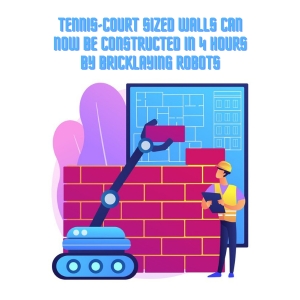Tennis-court sized walls can now be constructed in 4 hours by Bricklaying RobotsPosted by Atul on October 17th, 2023  Introduction to Bricklaying Robots in the Construction IndustryTechnology has been rapidly advancing in the construction industry with the introduction of bricklaying robots. And it's no surprise that the construction industry is also benefiting from these advancements. The use of technology has not only improved the efficiency and speed of construction projects but has also opened up new possibilities for design and innovation. Efficiency and Speed of Bricklaying RobotsOne major advantage of using bricklaying robots is its speed and efficiency compared to human workers. According to recent developments, these robots can now construct walls as big as a tennis court in just four hours! This feat is impressive considering it would take a team of human workers several days to complete such a task. These robots are equipped with advanced software and sensors that allow them to precisely place bricks in the desired position without any errors or delays. Cost Effectiveness of Using Bricklaying RobotsAnother benefit of using bricklaying robots is its cost effectiveness. With traditional methods, a large team of workers would be required to build a wall quickly, which would result in higher labor costs. However, with bricklaying robots, there is no need for a large workforce, which significantly reduces labor costs. Furthermore, these robots can work around the clock without any breaks or fatigue, making them more productive than human workers. Advancements in Robotics and Construction TechnologyAdvancements in robotics and construction technology have significantly transformed the construction industry over the past few years. These developments have improved efficiency, safety, and sustainability in construction projects. Here are some key advancements in these fields:
These advancements have the potential to increase construction speed, reduce costs, enhance safety, and minimize environmental impact. As technology continues to evolve, the construction industry is likely to see even more innovations that will shape the future of the built environment. The Rise of Bricklaying Robots in the Construction IndustryThe construction industry is no stranger to technological advancements. From using cranes and bulldozers to 3D printing, the industry has adapted to using innovative tools and techniques to make building faster and more efficient. One of the latest trends in the construction world is the use of bricklaying robots. You may have heard about automation in various industries, but did you know that it is now making its way into construction? Bricklaying robots are becoming increasingly popular among builders, as they offer numerous benefits over traditional manual labor. One of the most astounding capabilities of these robots is their speed. In fact, they can construct walls the size of a tennis court in just four hours! This feat would take human workers days or even weeks to complete. But what exactly are bricklaying robots? These machines are essentially large scale 3D printers that use mortar instead of plastic material. They can lay bricks with precision and speed, eliminating the human errors that often occur during manual bricklaying. The rise of bricklaying robots in the construction industry has many advantages besides just speed and precision. They also reduce the need for manual labor, which means fewer workers are required onsite, reducing labor costs for companies. Moreover, these robots can operate 24/7 without needing breaks or rest periods like humans. This allows for round the clock construction work, further decreasing project timelines. Key Features and Capabilities of Bricklaying RobotsAutomation has been a game changer in many industries, and the construction sector is no exception. With the introduction of bricklaying robots, buildings can now be constructed at an unprecedented pace. These robots have completely transformed traditional methods of bricklaying, providing numerous benefits to builders and construction companies. Let's delve deeper into the key features and capabilities of these remarkable machines.Efficiency and Speed:One of the biggest advantages of using bricklaying robots is their efficiency and speed. These machines can lay bricks at a rate that is five to six times faster than human workers. This means that projects can be completed in a fraction of the time it would take with manual labor. For instance, a tennis court sized wall can now be built in just 4 hours by these robots, compared to several days or even weeks with traditional methods. Elimination of Human Error:Another significant benefit of using bricklaying robots is their ability to eliminate human error in the building process. Unlike humans, these machines are not affected by factors such as fatigue or distractions, which can lead to mistakes in brick placement. The precision and accuracy of bricklaying robots result in perfectly aligned walls without any gaps or unevenness. Ability to Work on Large Scale Projects:Bricklaying robots have not only accelerated construction time but have also opened up opportunities for large scale projects that were previously not feasible due to time constraints and labor shortages. With these machines, buildings with intricate designs and complex structures can be erected quickly and efficiently. Benefits of Using Bricklaying Robots for Building Tennis-court Sized WallsEfficiency is one of the key advantages of using bricklaying robots. These machines are equipped with advanced technology and precision sensors that allow them to work tirelessly without any breaks or distractions. Unlike humans who may slow down due to various factors such as fatigue or weather conditions, these robots can continuously work at full capacity until the task is completed. This incredible efficiency also has a positive impact on labor costs. Traditional bricklaying requires a team of skilled workers to operate efficiently and accurately. With bricklaying robots, only one operator is needed to oversee multiple machines, significantly reducing labor costs. Moreover, these machines are not subject to human error, resulting in precise and consistent brick placement every time. In addition to efficiency and cost savings, using bricklaying robots also improves safety on construction sites. Bricklayers often have to work at heights and in hazardous conditions when building walls manually, putting them at risk for accidents and injuries. Bricklaying robots can safely perform this task from ground level or from within an enclosed machine, eliminating potential risks for human workers. Challenges and Limitations of Utilizing Robotic Technology for ConstructionOne of the most notable benefits of using robotic technology in construction is the increase in efficiency. Tasks that would typically take days or even weeks to complete can now be done in a matter of hours. One remarkable example of this is the construction of tennis court sized walls using bricklaying robots. These walls can now be built in just 4 hours, which is a significant improvement compared to traditional methods. How is this possible, you may ask? Well, these bricklaying robots are equipped with advanced sensors and algorithms that allow them to accurately place bricks with precision and speed. They can also work around the clock without breaks or fatigue, leading to a quicker completion time for projects. Apart from increasing efficiency, robotic technology also offers other advantages such as cost effectiveness and improved safety for workers. However, like any other new and emerging technology, there are some challenges and limitations when it comes to utilizing it in construction. Firstly, there is a high initial cost involved in purchasing and implementing robotic technology on construction sites. This cost includes both buying the robots themselves and training workers on how to operate them effectively. As a result, smaller companies may find it challenging to invest in this technology due to their limited resources. Check Out:Like it? Share it!More by this author |


